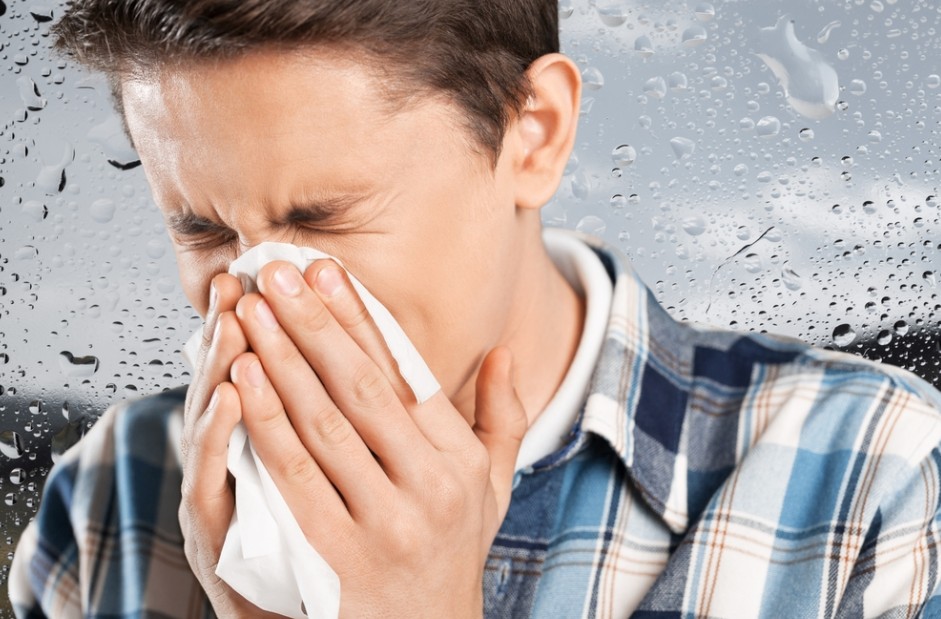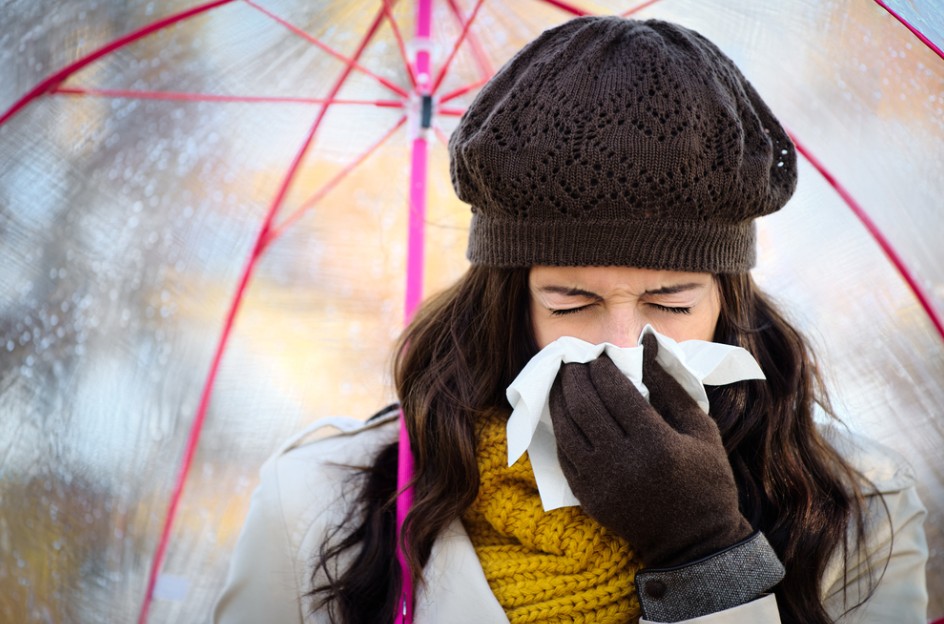Winter Health Guide: Understanding Common Illnesses
Winter is nearing, bringing familiar illnesses like colds, flu, and sore throat. What makes a runny nose or sore throat unique, and how do these illnesses differ? Your complete guide awaits.

It's relentless. You're sneezing and congested. It’s unpleasant. You might assume it’s the flu, but perhaps it’s not. So what is it? Dr. Dana Florentin, a family medicine specialist at Clalit Health Services and head of the Family Health Forum, provides us with a special guide.
What is a Cold?
A cold (or runny nose - Common Cold) is a viral infectious inflammation of the upper respiratory tract, displaying symptoms like a runny nose, sneezing, sometimes fever or sore throat, headaches occasionally, and a general feeling of malaise. Various viruses cause it, lasting usually about a week.

When do colds strike?
Mostly during seasonal transitions, although they can occur year-round.
Is it contagious?
Cold viruses spread through droplet infection in the air. Sneezing, coughing, and hand contact can transmit viruses from person to person.
Is there a vaccine for colds?
No, developing vaccines for the myriad viruses causing colds isn't feasible or economical. Imagine how many shots you'd need!
Does the body become immune after one cold?
Not really. With hundreds of virus strains, you can catch each one only once. Do the math.
Flu
So, what is the flu? According to Dr. Dana Florentin, the flu is a severe febrile illness caused by the influenza virus. Symptoms include high fever, muscle aches, headache, cough, runny nose, weakness, and an overall feeling of illness.
Flu symptoms are more intense than a regular cold and may include sore throat, conjunctivitis, and swollen lymph nodes in the neck. In short, the flu is a more serious illness than a cold. Historically, millions have died from the flu, especially infants and the elderly, whereas colds are rarely fatal and less likely to cause complications.
When does the flu occur?
The flu is a common seasonal illness, mostly appearing in late autumn and winter.
Is it contagious?
The flu is highly contagious, partly because the virus spreads in droplets emitted when an infected person coughs. In winter, when people crowd indoors, the virus transmits easily.
Flu viruses travel through airborne droplets, thus sneezing, coughing, and hand contact (with the face or a sick person) can spread the virus. The flu is contagious from a few days before symptoms appear until about five days afterward.
Interestingly, in 20%-40% of cases, the virus enters the body without causing symptoms, turning carriers into spreaders. Influenza viruses can spread rapidly through regions like computer viruses. In an outbreak, up to 40% of a region's population can be affected in about four to six weeks.

How can it be prevented?
Flu vaccines are available and consist of weakened or inactivated viruses that the World Health Organization experts predict will be prevalent that season. Typically, flu vaccines have no side effects, though mild fever and discomfort might occur for two days post-vaccination. The flu shot does not protect against the myriad viruses causing the common cold.
Who should get a flu shot?
Everyone is recommended to get vaccinated, especially vulnerable groups: children under five, adults over 65, people with chronic illnesses, pregnant or planning to be pregnant women, and postpartum women.
Why does the flu hit every winter?
Unlike other viral diseases like measles, chickenpox, or hepatitis A, where we usually get sick once in life, the flu virus can commendably mutate its genetic properties annually, evading immune responses.
Influenza includes two main strains: A, affecting humans and other animals, and B, affecting only humans. Most flu illness results from the type A virus, partly due to its mutation ability.
What are flu complications?
For young people, it might just be a bothersome week. However, in young children, the elderly, and those with chronic illnesses, the flu can lead to complications like pneumonia. Rare complications include encephalitis, exacerbation of pre-existing chronic lung disease, myocarditis, and Guillain-Barré syndrome.
Is there a cure for the flu?
Generally, no special treatment is needed as the body fights the virus on its own. High-risk individuals may use antiviral medication like Tamiflu, which can shorten illness duration and relieve symptoms if taken within 48 hours of onset.
Bronchitis
What is bronchitis?
Bronchitis (or bronchitis, Bronchitis) refers to inflammation of the bronchial tubes. It can arise from viral or bacterial origins, sometimes starting as a basic cold that progresses.
The disease is common among smokers, emphysema patients, those with chronic bronchitis (often due to smoking), and asthmatics. Symptoms include coughing with significant phlegm, sometimes breathlessness, general unease, headaches, fever, and weakness.
When does bronchitis occur?
Primarily in transitional seasons and winter.
What are the complications?
Bronchitis usually resolves on its own within a week, with or without antibiotics. However, the inflammation can worsen into pneumonia, especially in chronic lung disease sufferers, patients with chronic illness, and smokers. Another excellent reason to quit smoking.

Is it contagious?
Yes. Those causing the illness spread easily through airborne droplets, with sneezing, coughing, and hand contact transmitting the bacteria.
Does immunity develop after having it once?
Not quite. Many viruses can cause bronchitis, so you can catch each strain only once.
Sinusitis
What is sinusitis?
Sinuses are air-filled spaces within the skull, draining into the nasal cavity. Sinusitis (Sinusitis) is inflammation caused by viruses or bacteria in one or more sinuses. It often follows a cold where sinus drainage is blocked, leading to inflammation.
How can you tell it's sinusitis?
Sinusitis presents with headaches, especially when bending over, prolonged purulent nasal discharge (sometimes from one nostril), fever, and pressure pain over the affected sinus.
Is it contagious?
The contagious phase is only during the cold phase preceding sinusitis.
Is antibiotic treatment necessary for sinusitis?
In about 85% of cases, sinusitis resolves without antibiotics; however, prolonged high fever and severe headaches may necessitate such treatment.
Sore Throat
What is a sore throat?
Sore throat (Laryngitis) is an inflammatory condition of the throat caused by viruses or bacteria. There are two types: bacterial and viral sore throat.
Bacterial sore throat is mostly caused by the streptococcal bacteria, presenting with sore throat, swallowing difficulty, fever, headaches, and muscle aches, for which antibiotics are recommended.
Viral sore throat arises from various viruses, presenting with a burning throat, hoarseness, runny nose, and cough, typically resolving without antibiotics as they don’t combat viruses but rather bacteria.
Is it dangerous?
Viral sore throat is not dangerous and resolves by itself. Untreated bacterial sore throat can progress to acute sore throat and rarely causes complications like rheumatic fever affecting the joints, heart, or brain, thus the importance of treatment. Antibiotic treatment prevents such complications.

How is it diagnosed?
Diagnosis is usually through physical examination by the doctor, inspecting the throat ("Open wide...") for pus or slight redness on the tonsils. These findings along with symptoms point to the right diagnosis.
The presence of pus on the tonsils with high fever, but without runny nose, cough, or hoarseness, indicates a bacterial infection. If unsure, a throat swab can be taken for lab culture.
Is it contagious?
The causing agents spread easily via airborne droplets, so sneezing, coughing, and hand contact can transmit the viruses or bacteria from one person to another.
When should you see a doctor?
1. If a high fever (above 100.4°F) lasts more than three days. 2. If cough worsens, with purulent sputum and chest pain. 3. If experiencing shortness of breath. 4. If experiencing sharp ear pain. 5. If facial pain and purulent nasal discharge last over a week. 6. If high fever, severe headaches, sensitivity to light, and vomiting develop simultaneously.
Treatment for Winter Illnesses
For ordinary colds or flu, recovery will occur even without treatment. Nonetheless, to lessen the suffering, certain medications can relieve symptoms:
1. Bed rest, plenty of fluids, and some homemade chicken soup.
2. Acetaminophen can help reduce fever and improve general feelings.
3. Expectorant syrups and pills can help clear phlegm from the lungs. Options include Mucolyt, Reolin, Solvex, or Mobecks.
4. Codeine-containing syrups and pills can suppress cough reflexes, aiding better sleep.
5. For runny nose, nasal drops or sprays like Otrivin are recommended. Limit use to five days, as prolonged use may paradoxically induce chronic rhinitis. A saline nasal spray is another option; it can be bought or made at home. Tablets for runny nose like Sinufed, Nosidex are available as well.
6. For soothing sore throats, use locally numbing lozenges like Strepsils, Calgron (Rafathricin). Best remedy: mix a teaspoon of salt and a quarter teaspoon of baking soda in a glass of tap water and gargle.
7. Combination tablets such as Dayquil, NyQuil, Coldrex, etc.
8. Asthmatics and smokers may need inhalations and bronchial dilatation treatments.
9. Sometimes antibiotic treatment is needed, requiring a doctor's prescription.

